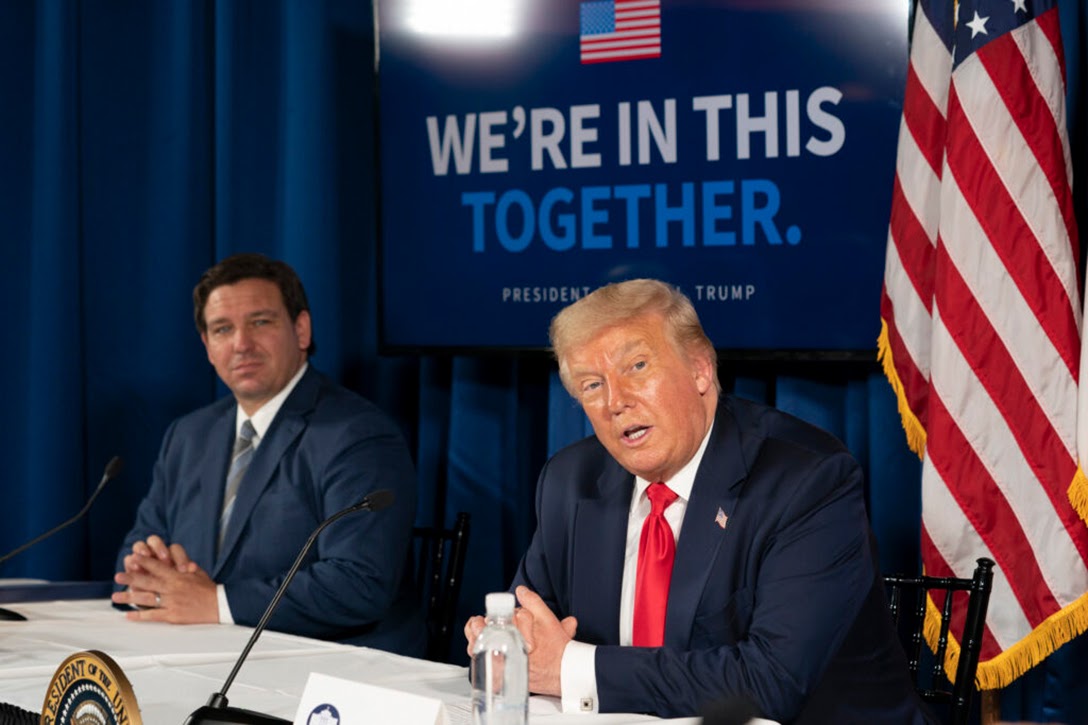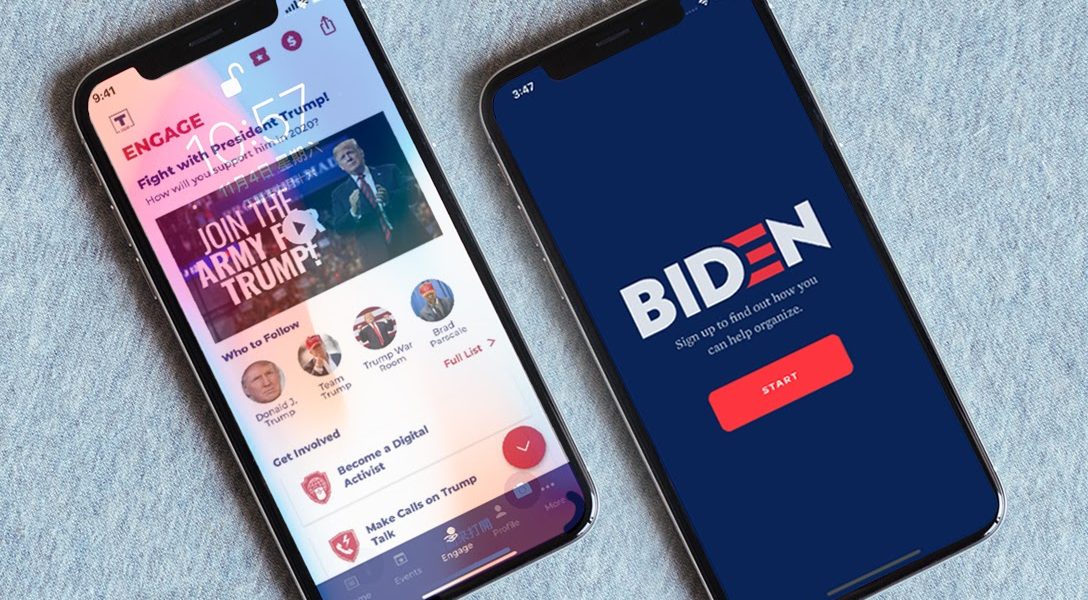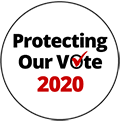Getting out the vote has never been more important, and now that face-to-face methods have flagged, the campaigns must move online. Can they still be effective?
|
Listen To This Story
|
The coronavirus pandemic has forced most everyone into virtual spaces: the school, the office, the weekend get-together — all have moved out of the physical world and onto our screens. The 2020 election season is no different.
Meet and greets and canvassing are going online because they have to. And rallies, at least for the Democratic side, are no more. But politicians have a pressing need to rally strong voter support nationwide, especially from key groups in battleground states like Florida. For Joe Biden and Donald Trump, Florida is vital. It is the largest, at 29 electoral votes of the 8 swing states. Both campaigns are moving into the digital arena.
“Virtual watch parties, phone banks over Zoom, and even ‘Ridin’ With Biden’ caravans — it’s clear. The energy, momentum, and mobilization is real for Joe Biden in Florida,” said Carlie Waibel, the Florida communications director for Biden’s Coordinated Campaign.
The Florida Democrats have also just released a wholly redesigned website, the first major overhaul of the site since it originally launched in 2014. Branded as a starting point for any Florida resident looking to get involved with the party, the website features information on congressional and state officials, including all their social media accounts, a streamlined process for voter registration, information on vote by mail, and an overview of the 2020 ballot.
Though a website upgrade was already in the works, the push to release it at this moment came, in part, due to the need for digital organizing during the pandemic.
“I think we thought specifically about what additional updates needed to happen due to the pandemic and how much was online,” said Alexandra Caffrey, the elections press secretary for the Florida Democratic Party, “and then we moved it to the top priority list and edited it to meet the moment that we’re in.”
Winning Florida could be necessary to win the election, according to many analysts. In the past, the margins have always been close. Remember: Florida helped to decide both the 2012 and 2016 elections, with Barack Obama and Donald Trump winning by a 0.9 percent and 1.2 percent margin, respectively. In 2000, the presidential election results were delayed for more than a month because the vote in Florida was so close, leading to a recount throughout the state. Ultimately, the Supreme Court, in Bush v. Gore, stopped the recount, resulting in the election going to George W. Bush.

Florida voters have voted with the winner of the presidential election every year since 1964 (with the exception of 1992). Florida has also voted Republican in eight of the last 12 presidential elections.
“The Democrats truly can’t keep up with the strength and size of our campaign,” said Emma Vaughn, the Republican National Committee’s Florida press secretary, in an interview with the Tampa Bay Times. “We truly are the campaign of the 21st century,” she added, citing the success of the Trump campaign’s robust grassroots digital organizing scheme, including “Trump Talk,” a program that allows volunteers to make individualized calls to possible voters and gain rewards for doing so.
In a race that can be decided by as little as 119,770 votes, digital organizing is crucial. Current moves to do this on both parties’ ends include Facebook pages, Instagram accounts, Zoom webinars, email blasts, text messaging, and other more “traditional” forms of digital organizing. Both the Republicans and Democrats, however, have also gone beyond those classic tactics.
“The biggest difference that I’ve noticed, between the Trump and the Biden campaign is that the Trump campaign has been very good at using live streams. [By] using live streams, what they’re doing is they’re using the features that the platform incentivizes.” — Michael Bossetta, social media expert and host of the Social Media and Politics Podcast
For the GOP, this is shown in Trump’s “tele-rallies.” Hosted a couple times a week, these telephone conferences invite members of key populations to join the president for what would be the digital equivalent of his in-person rallies (which he still continues to hold several times a week, despite the pandemic). This program began after the Tulsa rally on June 19, when Trump was greeted by a largely empty stadium.
“We will cement the things we’ve done and we will do much more,” Trump said at the August 19 tele-rally for Florida voters, before emphasizing the 2020 election as “the most important election in the history of our country.”
Though Trump still continues to host rallies, those who can’t attend can watch them on Facebook Live, a platform that Democrats are using much less often. At virtually any hour of the day, users are likely to see a Trump livestream, whether that be of a physical rally or of Trump TV, according to Michael Bossetta, a social media expert and the host of the Social Media and Politics Podcast. Because Facebook pushes its users to engage with Facebook Live, often sending people notifications whenever an account they’ve interacted with goes live, the Trump campaign is awarded a constant presence on the platform used more by older Americans.
Bossetta sees the Trump campaign’s use of Facebook Live as a “savvy” marketing technique. “The biggest difference that I’ve noticed, between the Trump and the Biden campaign,” he says, “is that the Trump campaign has been very good at using live streams. [By] using live streams, what they’re doing is they’re using the features that the platform incentivizes.”
The Democratic Party in Florida is using Zoom calls with local elected officials, such as a Zoom event between Jill Biden and Keith James, the mayor of West Palm Beach. Another example was the recent “Nuestros Negocios, Nuestros Futuros” event in Miami-Dade County. A Hispanic voter outreach program launched by Democratic running mate Kamala Harris, the virtual event featured Harris and Rep. Debbie Mucarsel-Powell (D-FL) in conversation with local Latinx business owners to rally support around Biden’s plan to increase Latinx entrepreneurship.
The Florida Democratic Party has also expanded to more innovative forms of digital organizing — like Snapchat stories and Spotify playlists — as part of efforts to “meet voters where they are,” which, according to Waibel, has always been the party’s goal.
“And even though President Trump’s disastrous coronavirus response has meant we have had to think up new ways to engage and communicate with voters while also keeping them safe, that mantra holds true,” she said.
@flademsIt’s election day! You can find polling location IWillVote.com and our Voter Protection Hotline is (833) 868-3352 🗳 ##fladems ##democrat ##florida♬ original sound – fladems
Among these is the official Florida Dems TikTok account, where party organizers share information on Democratic candidates up and down the ballot. They talk about how to register to vote, and give insights on Biden’s platform — all shown through the popular TikTok trends that have taken over the social media app. While the potential TikTok ban could lead to the end of digital organizing avenue, the Dems Snapchat Account (@fldemocrats) covers a similar audience.
Coupled with their Instagram account — which they use to advertise campaign events, encourage people to vote by mail, and provide easily shareable content — the Florida Democratic party hopes to mobilize young people’s support in the highly contested state.
“We’re trying to diversify as much as we can because Facebook, Twitter, Instagram, Snapchat — all of these platforms have different demographics and they have different target audiences,” says Florida Democrats’ Digital Organizer Alexzahn Odishelidze. “And so because of that we adjust our plan [so] that we’re not posting the same things on all the platforms, so that we can try and make sure that we’re connecting with as many voters in Florida as we can.”
On TikTok, the presence of independent organizers is especially palpable through accounts managed and shared by young activists from both sides of the political spectrum.
On the Democratic side are the Biden Digital Coalition and the Democrat Hype House, both of which aim to garner support for Democrats and liberal policies across the ballot, but also to vote Trump out of the White House.
On the Republican side, there is MagaHouse and the Republican Hype House, a small collective of Republican content-creation teams who, according to their biography on their website, aim to “[bring] youth into modern day conservatism” through short-video content on the Gen-Z dominated platform.
Because of the generational cleavages between Baby Boomers and Millennials or Gen Z, however, one shouldn’t expect to see too much of a Republican presence on these platforms catered towards younger people, according to Bossetta. “Platforms like Snapchat, Instagram, Tiktok, in theory, would have more of a Democratic base,” he says, pointing out, too, all the activism through the Black Lives Matter movement that is more prominent on platforms like Instagram and TikTok.
“But at the same time,” he says, “historically, these voter blocks are less valuable to campaigns because many of the users aren’t 18, and many of the users who are 18, don’t have the spending capability to fund campaigns.” After all, Bossetta states that this is what digital organizing is most used for:
“What we see from looking at social media posts… is that they’re not focused on a policy, really, at all. They’re used for more strategic things like fundraising, or signing people up to email lists…. I don’t really think they’re changing anyone’s mind.”
Josh Scacco, a researcher and professor at University of South Florida, agrees that social media advertising’s main role is campaign mobilization, not persuasion — a goal facilitated by the potentially dangerous ability to micro-target on platforms like Facebook. It is a practice that was widely used by the Trump campaign both in 2016 and now, but that has become increasingly popular. In Florida, for example, a Michael Bloomberg-supported super PAC, Priorities USA, is micro-targeting Latinx and Hispanic voters with specific messaging according to Scacco.
Micro-targeting is when campaigns acquire and exploit personal behavioral data from individuals’ online activity in order to target increasingly narrow groups and demographics with their advertising.
“In a polarized environment on social media, … micro targeting is about finding favorable ground and finding individuals who might be disconnected from the political process, bringing them into the political process, and making them realize that they already agree [with a campaign]…. It’s not meant to persuade,” Scacco says. “And so what the danger of that is that campaigns are very rarely talking about a broad swath of issues to a broad swath of voters.”
Despite its heightened visibility during the coronavirus pandemic, digital organizing is not a wholly new phenomenon. In recent election cycles, both political parties have made use of social media accounts across platforms like Instagram or Facebook.
Historically, digital organizing has been used to increase outreach to and enthusiasm among marginalized populations. Through online ads or a robust social media presence, campaigns are able to reach a broader expanse of people than they would through a localized campaign event. Campaigns can also make use of digital information databases to target specific populations. An example is what the Trump campaign did with its robust digital organizing campaign in 2016, which targeted people who were already supporters with thousands of Facebook ads.
Facebook, in particular, has maintained its reign as the ideal digital platform for campaigning. “Facebook is still the most valuable because of its targeting capabilities,” says Bossetta, citing the platform’s capacity to micro-target key demographics with advertising, “because that’s where you have older, wealthier, more likely to vote, voters,” he adds.
Still, digital organizing has had its drawbacks. Campaigns organizing online often have fewer regulations which can lead to false or misleading advertising — as exemplified by Mark Zuckerberg’s recent decision to allow Facebook to run political ads with disinformation.
In Florida, specifically, the Republican Party has capitalized off of the promotion of intentional disinformation on social media. On September 23, the Florida GOP took to Twitter to promote a video which falsely claimed that Joe Biden was reading from a teleprompter during an interview with Telemundo. Even though the news outlet responded to the tweet, writing that Telemundo has “never allowed someone who is being interviewed on its news programs to read answers from a teleprompter” and that the Florida GOP’s claim was “absolutely FALSE,” the originally false tweet remains online with no fact-check on Twitter’s part.
Republican organizers are pushing massive disinformation campaigns specifically targeting Latinx and Hispanic voters in Florida with conspiracy theories and falsehoods through WhatsApp.
“WhatsApp is very difficult to track,” says Scacco. “It’s very different and potentially more dangerous than what we saw in [the 2016 presidential election] with the Internet Research Agency in Russia using Facebook, because Facebook at least had the records of the ads that were run for investigation by the U.S. Congress.” This form of digital organizing, according to Scasso, has the potential to be highly volatile, not least because of the marginalized nature of the groups targeted.
Digital organizing has also been criticized for favoring rich campaigns with large funders at the expense of small, grassroots campaigns. These groups have more money to saturate the virtual sphere with political ads and propaganda, as Michael Bloomberg’s campaign did during the Democratic primaries.
Furthermore, digital organizing can increase interference from foreign powers, as was the case with the Russian operatives who used social media advertising, most notably on Facebook, to micro-target certain Americans to Trump’s benefit, as shown in former Special Counsel Robert Mueller’s 2019 report.
“The danger with these micro-targeted approaches is that you miss them. They might not be targeted at you so things might be moving under the surface that you don’t even know about,” says Scacco. “That’s really the danger if we think about 2016 and Russia…. You might not know but if you exist in an information environment where you are targeted, that’s a big problem. You might not realize you’re being targeted until it’s too late.”
As the popularity of social and digital media campaigning grows, so does the danger of media-savvy politicians, like Donald Trump, taking control of the media environment. Through Trump’s prolific use of short, catchy phrases (Make America Great Again) and insults (Sleepy Joe or Crooked Hillary) on Twitter and elsewhere, he is able to control the language not just of his supporters but of his opponents and the news media, who find themselves bringing attention to Trump’s claims in order to refute them. According to Scacco, “if you get people using the language that you use, you’re already halfway there to controlling the media environment.”
“At one point the internet was looked at as the way for average people to take down the Goliath, to take down the corporations and authoritarian regimes,” Scacco says. “And what we see now is we see political leaders inverting the process using the affordances of social media, using the outrage and emotionality of social media to be able to control the media environment.”
Still, if the coronavirus pandemic has shown political campaigns anything it is that digital organizing must be embraced. As evidenced by the success of the massive Facebook campaign run by Trump’s 2016 team, the shift towards digital organizing was already in the works; all the pandemic has done is expedite that shift.
As national crises like climate change and systemic racism gain prominence in the conversation, it becomes more and more necessary to increase organization efforts that rally massive amounts of people around a common goal, which digital organizing allows politicians to do on short notice.
When Justice Ruth Bader Ginsberg passed away on September 18, the Democratic party was able to quickly mobilize with ads calling for donations to support Ginsberg’s legacy. In an hour, ActBlue, a fundraising platform for Democrats, raised $6.3 million, the most they had raised in that time-frame since they were founded in 2004. A couple of hours later, Democrats had raised over $71 million dollars.
Of course, there will always be a place for physical campaigning once we are post-COVID-19. But even then digital organizing will probably be as important as it is now, if not more so.
Related front page panorama photo credit: Adapted by WhoWhatWhy from Harald Weiss / Flickr (CC BY-NC-SA 2.0) and DonaldTrump.com.





